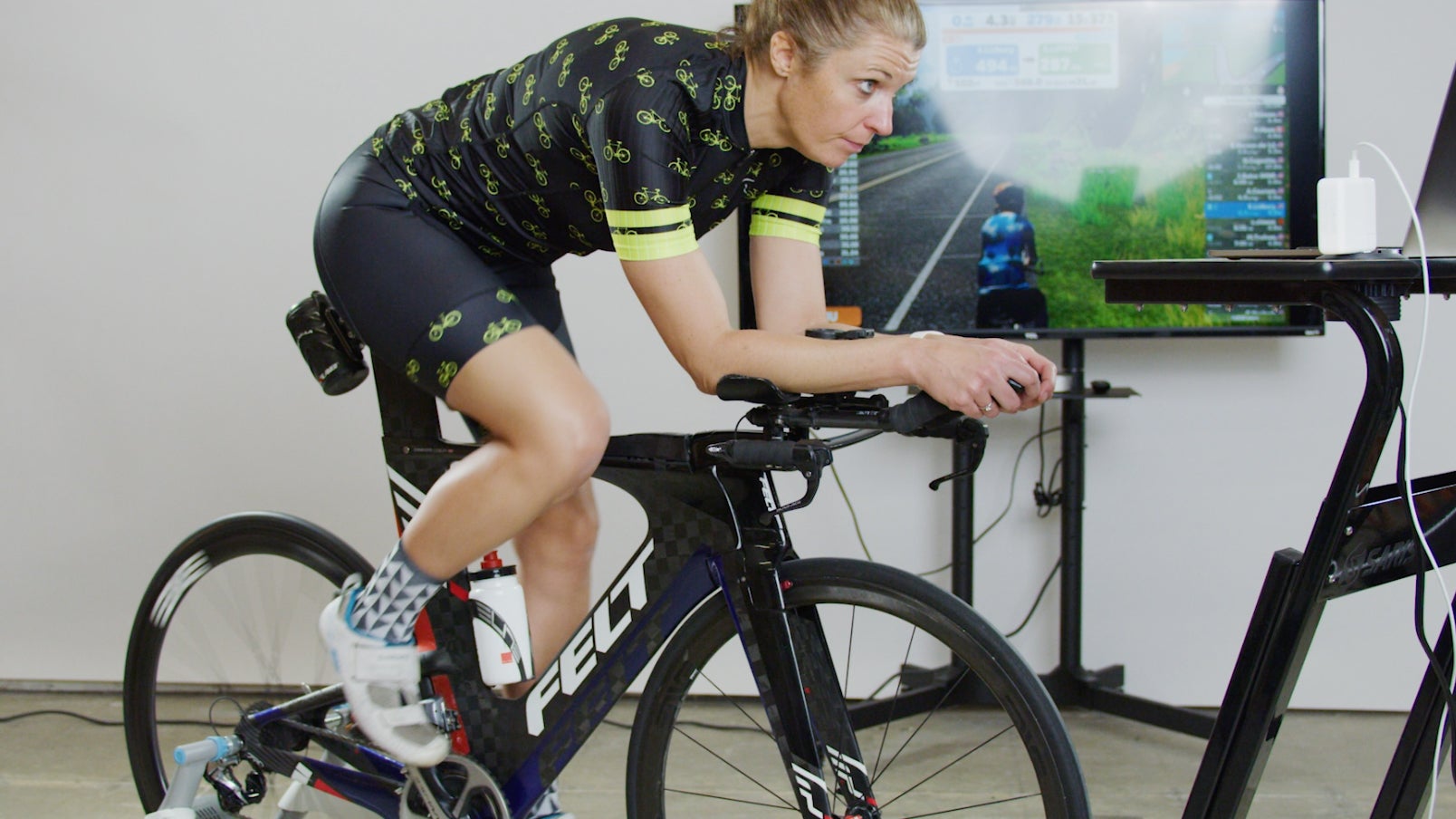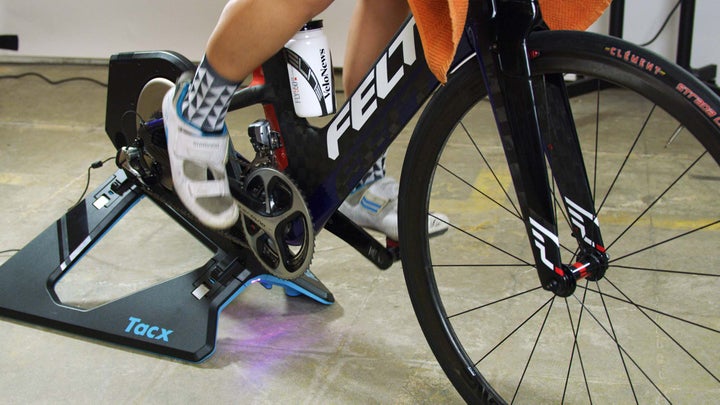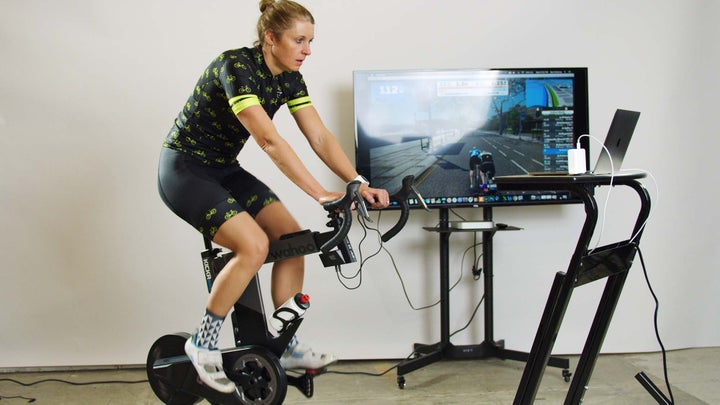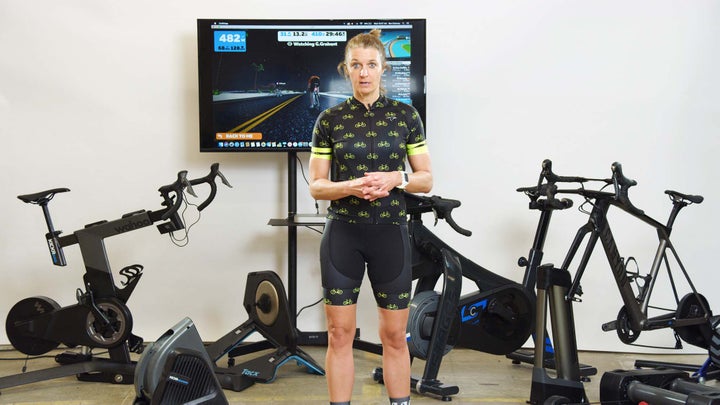The Coolest New Gear for Riding in Zwift

The Zwift training app is completely redefining the indoor riding experience, not only in terms of the software and the interaction but also the technology we use. In this video with Triathlete Managing Editor and former pro triathlete Emma-Kate Lidbury, we’ll walk you through three things you need to get going—and a number of cool new products that make riding in Zwift more fun and engaging.
First, the basics. To get into Zwift you’ll need three things:
- Your bike on a trainer—or a smart bike.
- An ANT+ or Bluetooth device, such as a smartphone, tablet, laptop, or Apple TV with a solid internet connection.
- A data source on your bike to allow those two things to talk to each other, such as a speed/cadence sensor, a power meter, or, ideally, this information from a smart trainer.
The whole game is based on interaction: Your pedal power drives your avatar, which interacts with other riders, workouts and the courses. And the game drives your technology, whether controlling resistance on a smart trainer, dictating the elevation adjustments on products like the Wahoo Kickr Climb or Kickr Bike, adding surface simulation on the Tacx Neo, or even controlling the speed of a fan.
Let’s look at some of the cool new tech. Smart bikes are the latest thing. They combine the controlled resistance of smart trainers with the convenience of a dedicated indoor bike. But let’s start with the simpler options first.
Wheel-on smart trainers
Wheel-on smart trainers set up like a standard trainer. You clamp your rear axle into the trainer and set the roller against your rear wheel. Unlike a standard trainer, however, a smart trainer will automatically change the resistance to both match the undulations of a course in Zwift and also to meet the prescribed wattage when doing workouts.
This type of smart trainer measures your power and speed. A variety of companies make wheel-on smart trainers, including Saris, Elite, Wahoo, and Tacx.

Direct-drive smart trainers
Direct-drive smart trainers also measure your output and allow the game of Zwift to control the resistance for riding, training and racing. These models have a higher level of accuracy in power measurement thanks to the removal of the wheel, tire and tire pressure from the equation. They are also often more stable—and more expensive.
One cool option is the Tacx Neo 2T, which offers something called surface treatments that add different vibrations to the riding experience to mimic cobblestones, brick, gravel and more. The Neo 2T also works unplugged. Wahoo, Elite and Saris also have solid options for direct-drive smart trainers.
Wahoo Kickr Climb and Headwind
Wahoo has a bevvy of indoor training tools and two of the most novel are the Kickr Climb elevation unit and the Headwind smart fan.
The Climb replaces your front wheel, and automatically adjusts the bike’s angle to match the gradient of virtual courses in Zwift. This is particularly useful when training for a specific race: You can learn how to ride the course months in advance from the comfort of your garage.
The Headwind fan is unique in that its speed can be programmed to react to either your speed or your heart rate: the harder you go, the harder it blows.

Moving platforms
Another option for indoor training are moving platforms, like the Saris MP1, which moves fore and aft and rocks side to side. With platforms, you secure your trainer and front wheel to the platform, and enjoy a dynamic experience.
Smart bikes
The latest and greatest technology for riding and racing inside Zwift is a smart bike. There are now options from Stages, WattBike, Tacx and Wahoo, but whichever brand you choose, one thing’s for sure—there are multiple benefits of the smart bike setup.
You have all the interactive benefits of a smart trainer, with the stability and the convenience of a dedicated indoor bike. You’ll never need to spend time setting up or taking your bike off the trainer—you can just open the door to your pain cave and get pedaling. And there’s the added convenience that smart bikes can be used by anyone in the household. You only need to adjust the bike’s measurements to get going rather than having to swap bikes and possibly cassettes/adaptors as you do with a smart trainer. This is also a bonus when it comes to cleanliness. You aren’t bringing dirty bikes into the house and equally you aren’t sweating over and ruining your pride and joy—this is a dedicated unit for indoor use.
The last benefit here is that a smart bike is plug and play. For new athletes, or possibly those not so confident in the mechanics, they don’t need to understand compatibility or which cassettes/spacers they need to get their bike on—they don’t even need to own a bike. A smart bike is ready to go out of the box, making your bike workout more accessible than ever.
The Tacx Neo Bike was the first smart bike on the market, and it provides the same surface treatments as the Neo 2T smart trainer. It can also be used with or without electricity.
All the bikes feature shifting of some variety. The Stages and Tacx bikes have tablet and smartphone holders plus two USB outlets.
The Wahoo Kickr Bike is unique in that it offers automatic elevation adjustment, making it the most dynamic smart bike to ride inside on Zwift.

Other options
In each of these setups, Zwift interacts directly with the smart bike or the smart trainer; Zwift controls the resistance, and the smart trainer measures your power, speed and cadence to drive the game. Those of you with power meters on your bike may want to use that to measure the power, just to ensure you’re getting the same readings that you do outside, as there can be a bit of variation between what your meter reads and what a smart trainer reports.
Does all this seem cool but way too expensive? Then you have your basic trainers and any standard trainer can work with Zwift provided that you have a speed/cadence sensor on your bike to measure the rear wheel speed and your crank revolutions. This configuration requires a bit more setup, as you have to do a roll-down test within the game to get a power approximation set based on your type of trainer. In this scenario, you aren’t going to get resistance controlled by the game—the interaction is one way, with your power driving your avatar. You can also use a standard trainer with a power meter on your bike. Again, this delivers one-way interaction with the game.
Pro tips
First off, download and use the Companion app. It has a few primary functions. You can use it for planning: looking ahead at what events are coming up, drilling it to the details of the available categories, distances, number of registrants and more. You can sign up for events with the app and they’re all free.
Then, once you are riding, you can use the app to message other riders in the game, either those riding near you or those involved in the same event. For us, this is one of the coolest parts of Zwift—the ability to not only draft riders from Australia, Belgium or wherever in real time, but to chat with them like you would on a normal group ride.
You can type with your thumbs or use the talk to tech function. Make sure your phone is fully charged and close at hand.
This leads us to the next pro tip: Set up your space so that you can easily reach what you need: your drinks, your phone, your towel and your fan. If you are using a laptop, make sure you can reach that on a stable surface.
Saris and Wahoo make trainer desks. The Saris option has USB and power outlets, which are handy, and the Wahoo desk has easy height adjustment.
Lastly—and this could well be the most important part—get yourself a powerful fan. You won’t last very long without ventilation.
And those are our tips! Hopefully this video and article has helped you get a better sense of what your options are for having a great time inside Zwift. See you inside the game!
This video was produced with underwriting from Zwift.